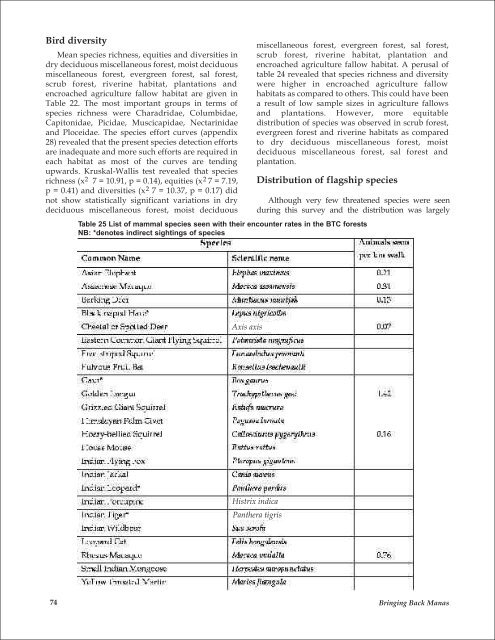Bringing Back Manas
Bringing Back Manas
Bringing Back Manas
- TAGS
- bringing
- manas
- www.ifaw.org
Create successful ePaper yourself
Turn your PDF publications into a flip-book with our unique Google optimized e-Paper software.
Bird diversity<br />
Mean species richness, equities and diversities in<br />
dry deciduous miscellaneous forest, moist deciduous<br />
miscellaneous forest, evergreen forest, sal forest,<br />
scrub forest, riverine habitat, plantations and<br />
encroached agriculture fallow habitat are given in<br />
Table 22. The most important groups in terms of<br />
species richness were Charadridae, Columbidae,<br />
Capitonidae, Picidae, Muscicapidae, Nectarinidae<br />
and Ploceidae. The species effort curves (appendix<br />
28) revealed that the present species detection efforts<br />
are inadequate and more such efforts are required in<br />
each habitat as most of the curves are tending<br />
upwards. Kruskal-Wallis test revealed that species<br />
richness (x 2 7 = 10.91, p = 0.14), equities (x 2 7 = 7.19,<br />
p = 0.41) and diversities (x 2 7 = 10.37, p = 0.17) did<br />
not show statistically significant variations in dry<br />
deciduous miscellaneous forest, moist deciduous<br />
miscellaneous forest, evergreen forest, sal forest,<br />
scrub forest, riverine habitat, plantation and<br />
encroached agriculture fallow habitat. A perusal of<br />
table 24 revealed that species richness and diversity<br />
were higher in encroached agriculture fallow<br />
habitats as compared to others. This could have been<br />
a result of low sample sizes in agriculture fallows<br />
and plantations. However, more equitable<br />
distribution of species was observed in scrub forest,<br />
evergreen forest and riverine habitats as compared<br />
to dry deciduous miscellaneous forest, moist<br />
deciduous miscellaneous forest, sal forest and<br />
plantation.<br />
Distribution of flagship species<br />
Although very few threatened species were seen<br />
during this survey and the distribution was largely<br />
Table 25 List of mammal species seen with their encounter rates in the BTC forests<br />
NB: *denotes indirect sightings of species<br />
Axis axis<br />
Histrix indica<br />
Panthera tigris<br />
74 <strong>Bringing</strong> <strong>Back</strong> <strong>Manas</strong>

















